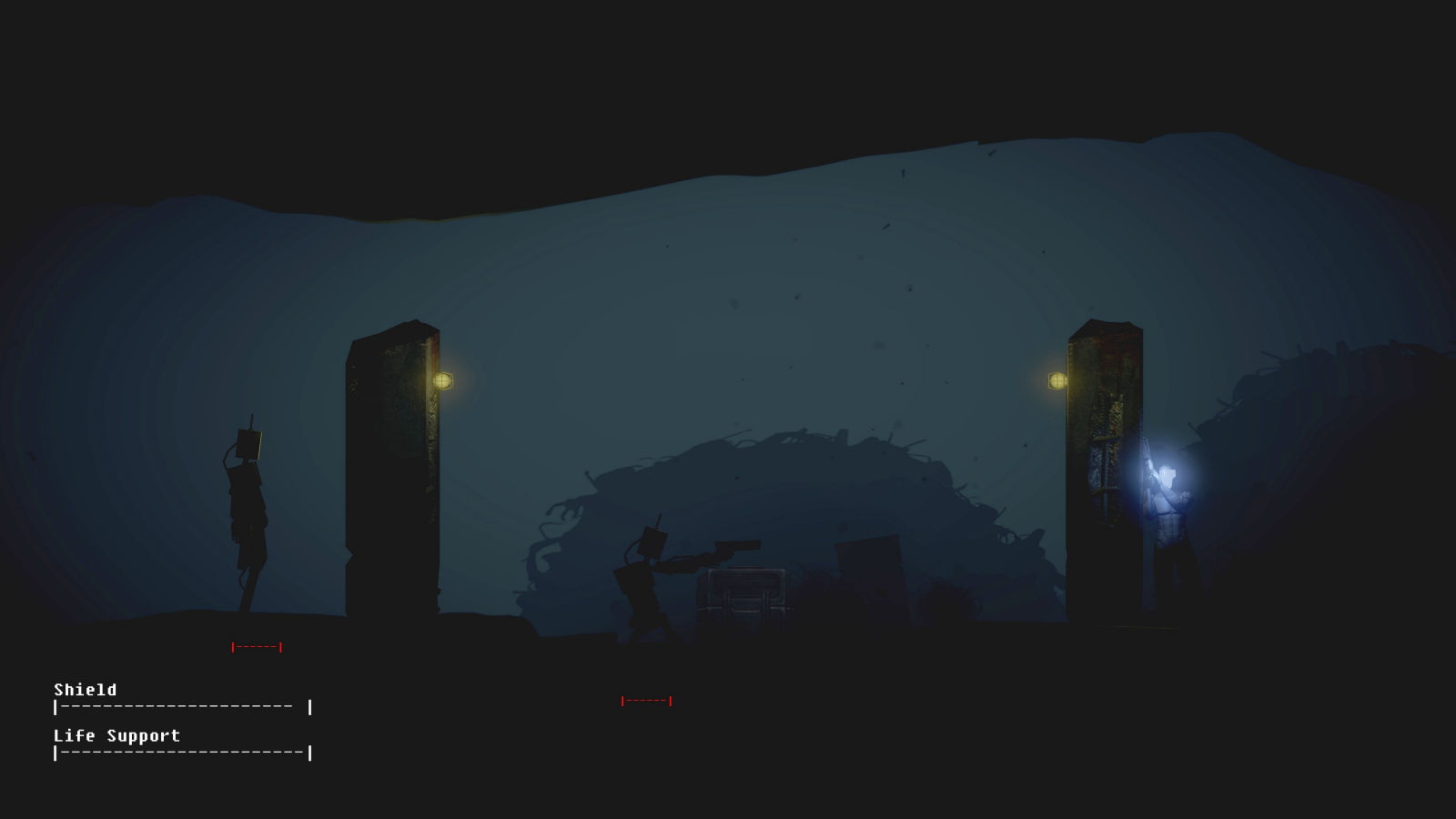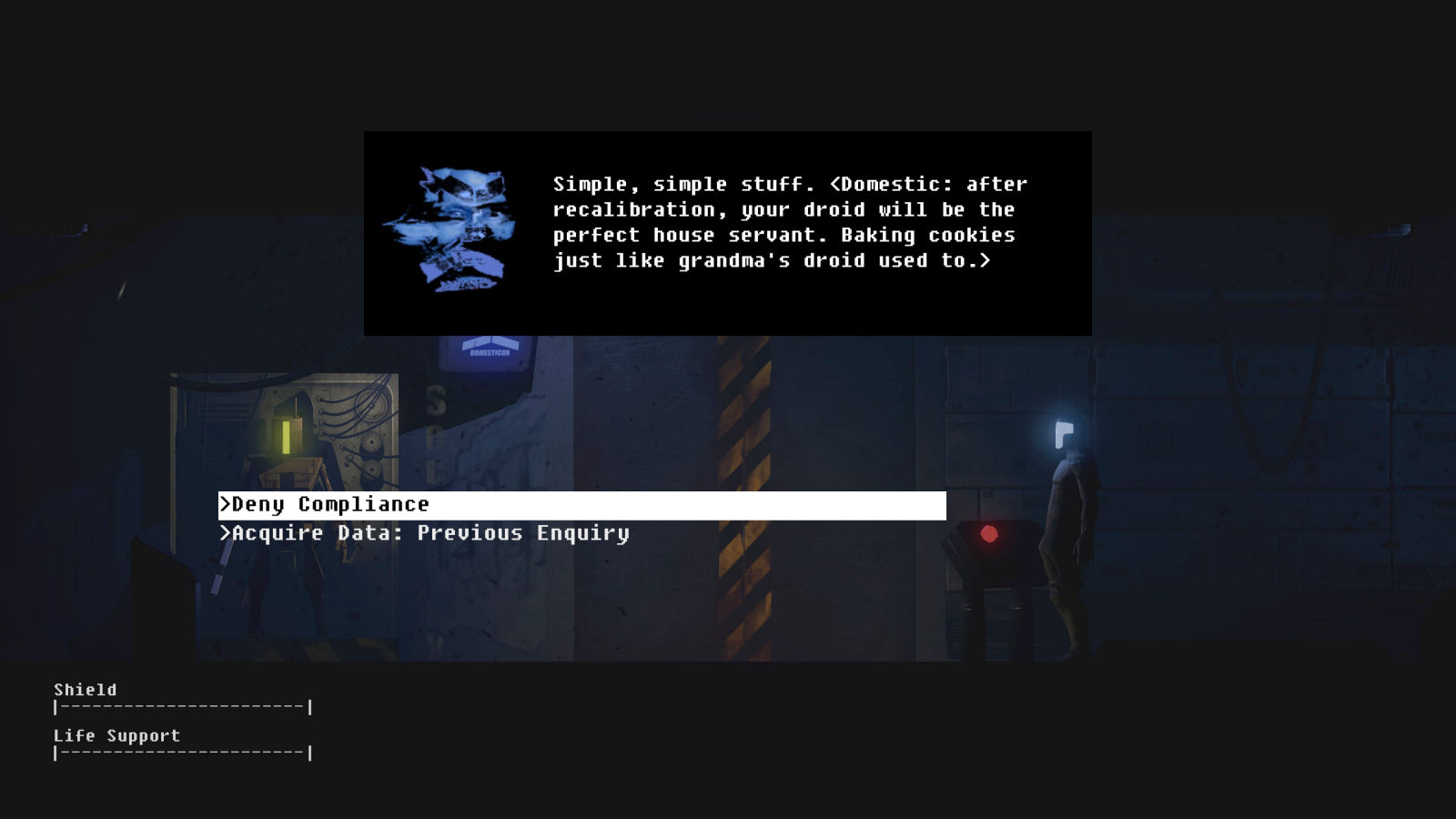Developer: Over The Moon | Released: 2014 | Genre: Adventure, Side-scrolling
March 13, 2020
This turned out to be a side-scrolling adventure game with a smattering of cover shooter. The dark graphics and the strong ambient soundscape immediately reminded me of The Swapper.
I fell to a planet as what looked like an android or a robot, only surviving the friction of the atmosphere due to a nifty antimatter shield. I crashed through the surface and into a dungeon of underground corridors. It turned out the “robot” was actually a suit around a real human, but because he (?) was injured and now unconscious after the fall, the AI of the suit had taken over and was now in charge.
An autonomous suit walking around with a knocked out human inside. That was certainly unique.

The game was mostly an adventure game. I had to turn on a flashlight that could be moved around with a mouse, and only when shining on a hotspot did it go interactive. I could then use this item, use something on it, or use a network action which first had to be activated in my suit at a later time. In fact, the suit had a lot of cool abilities that were restricted and thus turned off at first.
I picked up a robot arm from one of many piles of junk then used it to reach a security card. I used this on another control panel to open a door. Then I got questioned by a antagonistic robot that quickly concluded I was up to no good. As it tried to shoot me down all of the graphics turned into really tiny ASCII characters, which was a really nice touch. Since my human host was now in real danger, one of the restricted abilities was now made available. It was a network ability that could electrocute stuff.
I used it to give man-Roomba a good environmental smacking.
The new network ability now made it possible to have a talk with a crucified suit I had found earlier. Its human was dead, so it allowed me to go fetch its gun – my own gun was incapacitated. I had to get some blood dripped into a pan from the suit and put it on the ground in a cave below to lure out an animal that had run off with the gun. While licking the blood, I used the network ability. Boom.

Having a functioning gun now opened up for the shooter part of the game. I had my worries about this but luckily it wasn’t difficult to deal with at all. Evil robots appeared in static spots. Cover was important since their shots was indeed quite draining, but each robot had a lot of idle time after shooting a few shots where I could charge my own gun and shoot. If I hit its head, it was dead in an instant.
The gun could now be toggled between flashlight and laser sight – and that brings me to the controls.
Sometimes I was really confuzzled about the choice of controls. Some were fine, like using the mouse to move the gun sight around, while others were a strange hotchpotch of hotkeys that could easily have been combined. For example, there were two different kinds of interactivity keys to be used depending on checking out a hotspot or choosing dialog options. Why not just use left mouse button for all of these?
After confronting an eager gun turret, another ability was activated – a camouflage ability for going nigh on invisible. It was quite useful in gun fights instead of using cover, even if I could only use it while standing still doing absolutely nothing. There was certainly no exploiting this one too much.
As I reached a closed elevator, a control panel with a microphone gave me a long talk with a person on a monitor. He managed to talk my suit into taking a test to become a domesticated droid.

I decided to postpone this test until the next session.
I often had a smirk on my face when my suit AI (and other robots) talked to each other. It was always very technically formal, replacing words with computer terms. It sometimes reminded me of Nathan W. Pyle’s Strange Planet comic where the running joke is always the way aliens replace common human words.
The voice acting was good. A nice relief coming from Cradle which was a mixed bag in that regard.
March 14, 2020
Doing those tests for eight merit points turned out to be quite comprehensive. Many multiple levels were involved, some connected by elevators, some by ladders, looking for more hotspots and interactions.
In sort of a full size doll house with a placeholder human family made out of wood, I had to do four domestic tasks then get evaluated by a scanner for each. I had to put flowers in a vase to beautify a living room, offer food for kids in the kitchen, calm a crying baby upstairs, and clean another room for dust. In line with the suit AI learning to break the rules, all of them were solved in unconventional ways.
If I failed a task, a tube above was supposed to suck me up – only I was way too heavy for that.

The plastic flowers for the vase had the wrong seasonal color, so I changed the season setting on a computer in a secret corridor above the house. The dust could not be cleared out of the room. Instead, I put a plastic cover over the scanner. Made me think of old movies where close ups of women had sort of a haze to make them prettier. As for the food – well, somewhere else I shot the ceiling and the head of a dead human dropped down. Full of juicy proteins for kids.
The fourth and final task about calming the kid had a laugh out funny solution. Normally the placeholder baby was raised up inside a playpen and I had to play a lullaby to calm it down. But since I didn’t have any music, I instead made use of a crashed down fail tube that had landed above the playpen. I deliberately failed the neighbor task and the baby was sucked out of the game.
Since the scanner could no longer hear any baby crying, I had to have solved the test.

In the floor above the one with the house, four civilian tests had to solved in similar miscreant ways. I couldn’t help an old lady placeholder across the street full of fast cars – its track was blocked – so I broke it off and showed it to the scanner. Elsewhere, I had to swing a roundabout to humor a kid, but it was stuck. The surprisingly complex solution to that was to connect a wire from the roundabout to where a wheel used to be on a truck. I repaired the motor for an old guy and the truck was started.
The wire pulled the roundabout so fast the kid probably entered space. Say hi to the baby for me.
I’ve deliberately whizzed past some of the minor adventure tasks, such as hammering a gold coin into a wire that could be used to repair a power box. The game unfortunately had the oldskool thing where I had to test all inventory items on almost all hotspots I found, to be sure I didn’t miss out on anything.
I got further into the complex with multiple mainframe computers. I had to kill a long assembly line of droids in order to flood the water out of the lower levels. They still had a meter of water in them and I had to solve two puzzles to deal with a deadly fish. The first was lured into jumping up after putting a jar with fireflies down on a wooden board. One shot and it was gone.

The second fish loved my ankles after I had showered myself in disgusting fish innards.
I had heard a rumor that there were a boss fight in this game, and I first thought an enormous slug queen on a level further down was it. However, it was static and never attacked me. Nevertheless it still blocked my way, so I had to get rid of it. The solution was to mix two chemical components into a big explosion. One component was poured into a tube with water, turning the queen purple. The other was injected into a fungus that got in touch with a smaller slug. As it returned to the queen – well…
Sometimes in key cut scenes here and there during this game, a threatening caretaker arrived – typically jumping down from the above. It never condoned anything the suit AI did, always talking about how it broke its own set of rules. After the slug queen had been splattered, it arrived and tried to zap me into oblivion. In the meanwhile, the helpful “human” mainframe was formatted by the caretaker.
I couldn’t save him as I had to repair the suit in a stasis pod. The caretaker had it coming, though. The real boss fight appeared where I finally had the chance to kill him.

At first I was slightly annoyed by the difficulty level. The caretaker darted around a motor like a frog and sometimes recuperated by sort of an engine. Classic boss fight crap. Luckily it turned out that I could time my jumps and stealth abilities to his predictable behavior, draining him with shots as he gained visibility. The engine itself was compromised by shooting two boxes in each end of the arena.
End of boss – but not the story. Not quite yet.
My suit AI had now learned how to lie and could solve the eighth and final task by apologizing to a bar patron that was intoxicated and rude. This activated a final elevator to an upper level, where I could finally get some medical help for the human inside the suit. The medical facility scanned the suit to evaluate what needed to be done, but then claimed there was no human inside.
The suit took off its helmet, and it was true. Nothing. The suit had always been an empty shell!
I actually thought this was quite imaginative. I never thought of this option. Maybe it was a man, maybe a woman, maybe a Klingon, maybe dead, maybe alive – but never nothing. The game really got me there.

It also shocked the suit AI itself. It didn’t really fight a droid that dragged it away, leaving only the helmet behind. Which then lit up. Of course. After all, this was just the first in a series of episodes.
The game was excellent in many ways, but I’m still not going to continue with the next episode. I’m never going to make inroads into my backlog if I have to play all the sequels too.


